
Kenneth Walker only participated in positional drills at Michigan State’s Pro Day after running backs weren’t able to do agility testing at the Combine. So his athletic profile isn’t as complete as we would like:
Probably my number one point of interest going into the Combine was Walker’s weigh-in. For reasons we’ll go over later, it was especially important for him to have the size of a guy who could reasonably get high-volume early-down work in the NFL. At 211-pounds, he’s a bit undersized (average is about 214). But given that he’s sub-5’10, that might be good enough. At 3.05 pounds per inch, he’s proportionally built like Kareem Hunt or Alvin Kamara.
Walker’s 40-yard dash time was among the more notable out of Indianapolis. Both his 10-yard split and Flying 20 (which just looks at the final 20 yards of the 40) are excellent. He’s less impressive from an explosiveness standpoint. His performance in the jumps combine for a 51st-percentile Burst Score. That’s difficult to reconcile with his incredible 10-yard split which, theoretically, is also predicated upon explosion. I hypothesize that, because the 10-yard split can be perfected through technique, jumping drill performance is more indicative of his explosiveness than is his start out of a sprinter’s stance in the 40. But who knows.
Based on the above measurables, the following historical prospects are Walker’s most similar from a purely physical standpoint:
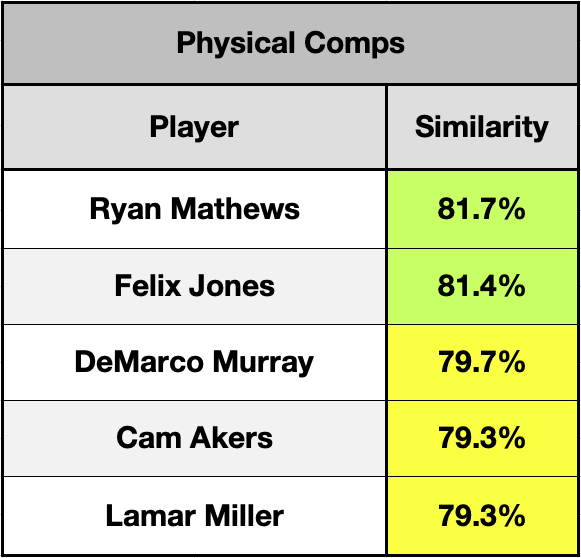
It’s not often that you get a comps list made up completely of legit NFL talents. Though we’re more just assuming Cam Akers is that at this point. All of these guys are at least five pounds heavier than Walker is. Though guys like Maurice Jones-Drew and Ray Rice would be among the next five. But proportionally and athletically, they’re decent approximations of him.
Production Profile
Kenneth Walker spent his first two seasons toiling away on bad Wake Forest teams before transferring to Michigan State and absolutely blowing up:
It’s worth mentioning that the massive jump in Dominator Rating that he experienced from Year 1 to Year 2 did not come with an uptick in yards gained. He had just 13 more yards from scrimmage as a sophomore than he did as a freshman. But his touchdowns jumped from 4 to 13, thus the massive difference in Dominator Rating. Nonetheless, a breakout is a breakout.
Walker then completely legitimized that production by laying waste to Big Ten defenses all of last season. Overall, he completed the triple crown of posting upper-percentile market share numbers on an above-average college team after breaking out as a teenager. Quite legit.
Given the seasonal Dominator Ratings he posted and the quality of teams he played for, the following historical prospects had the most similar college production profiles:
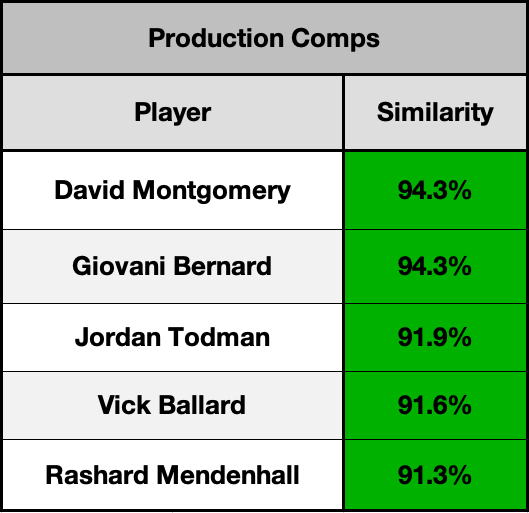
The David Montgomery production comp is one of the cleanest I can imagine, and it’s a nice window into the overall quality of player we might expect Walker to be in the NFL.
Rushing Efficiency
I wrote a full breakdown on Kenneth Walker‘s rushing efficiency profile that can be found here. The following is a good overview:
Walker is simply one of the best pure runners we’ve seen come out of college in a very long time.
He’s a tackle-breaker. He’s an open-field savant. And he was both incredibly efficient and incredibly consistent relative to his teammates at Wake and MSU. From an analytical perspective, there are no holes in his repertoire as a runner.
The only negative mark on his profile is that the backfield teammates he was outpacing on the ground were not an especially talented group. They collectively averaged just a 2.90-star rating as high school recruits. However, given a player’s carry volume and the talent level of a his teammates, historical data says that we should expect an NFL-quality runner to post a YPC+ mark of 0.56 in the same situation that Walker operated in. He was nearly three times better than that.
Given his physical profile in combination with the above metrics, the most similar historical prospects to Walker from a “pure runner” perspective are:
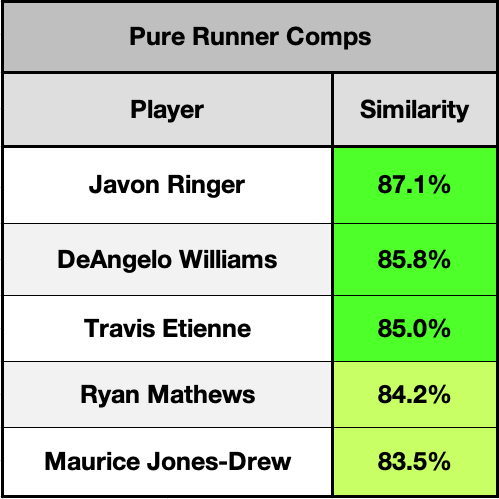
This is the part of the Vince McMahon gif where he tilts his head back and starts hyperventilating into the sky.
Receiving Chops
Normally, McMahon would then fall out of his chair, but we’ve now reached the receiving portion of the Kenneth Walker profile. As Nacho once sang about Encarnación, the fantasy has ended:
There’s no just statistical measure that indicates that Walker is at all likely to be even an average receiver as an NFL running back.
His role in the passing game was not large at either college he attended. He did not prove capable of being deployed dynamically. And he might have stone hands.
This is a good opportunity to address a point I’ve seen raised in his favor in this area. The contention from the Sparty homers and Walker stans is that MSU’s quarterback was just very bad and very inaccurate, and that his poor efficiency numbers are a result of that poor play.
I decided to account for that hypothetical context by looking at Walker’s numbers only on catchable targets, and he does look much better there. So much better, in fact, that he rises all the way from having the worst raw Catch Rate among 38 rookie running backs to ranking No. 30 among that same group in True Catch Rate. The Spartans quarterback certainly made him look worse than he really is. But he was plenty bad on his own.
Given the above metrics, here are the historical prospects whose receiving profiles most closely resemble Walker’s:
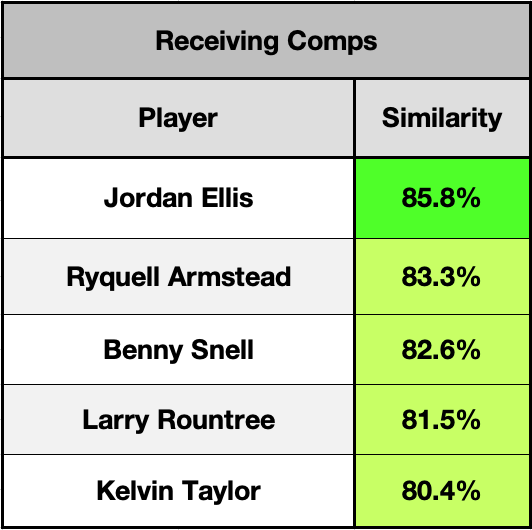
Obviously, none of these guys have been quality pass-catchers at the NFL level. Walker might have a chance though, given that he didn’t fall over himself while running routes against air at the Combine. You guys should see my nephew play catch, too.
Overall Profile
I’m just so torn on Kenneth Walker. One one hand, he’s a fantastic runner with great college production. On the other, he’s undersized and doesn’t apparently possess the ability to contribute as a receiver. That combination is very often a death sentence for a player’s potential to be a high-end fantasy contributor. Even among guys who were great collegiate runners.
Guys like Ronald Jones, Chuba Hubbard, Bilal Powell, Bryce Love, LaMichael James, and Tevin Coleman have come through the pipeline as (to varying degrees) undersized backs without strong receiving profiles. None of them have made good on their rushing talent in the NFL. And I’m not sure what it is about Walker that’s supposed to make him different. He’s arguably the worst receiver among them as prospects.
He’s a little bigger than most of them, so that’s a point in his favor, but being bigger than Bryce Love doesn’t erase the fact that he’s small relative to the greater population of players at his position. He also posted a better 40-time at the Combine than all those guys did (outside of James). But I’d have a hard time buying into the idea that Ronald Jones’ problem is that he’s not fast enough.
I think it’s easy to look at a great college football player and have a hard time picturing how he could fail in the NFL. It’s also easy to look at a list of past busts and say, “yeah, but this guy is good, he’s obviously not like them.” None of the above players were drafted later than the fourth round. James and Jones were both taken in the second. They were like Walker once, and draft capital is not some magic elixir that erases a prospect’s flaws.
But I digress.
Last Word
The historical prospects whose complete profiles were most like Kenneth Walker‘s are the following:
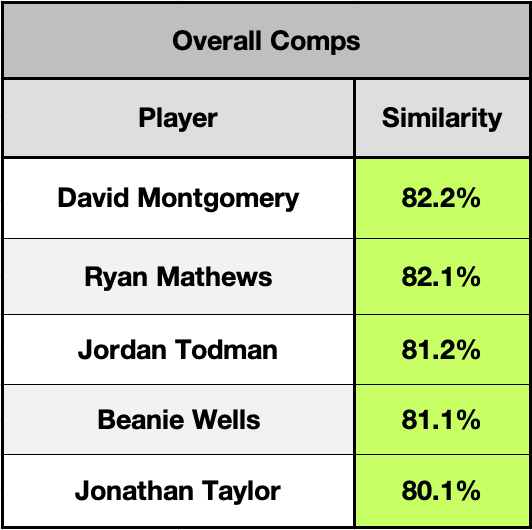
The similarity percentages here indicate that these are not the cleanest comps, and that makes some sense. It’s difficult to find players who were as productive and efficient as Walker was on the ground while also being small non-receivers.
David Montgomery and Jonathan Taylor can both match elements of Walker’s profile, but they’re each over 220-pounds. Beanie Wells had the same combination of rushing efficiency and non-existent receiving production as Walker does, but he was 235-pounds. Ryan Mathews is probably the cleanest skillset match for Walker on this list, but even he was 6-0, 220-pounds. Jordan Todman was both small and not a great pass-catcher, but he also ended up being a bad player.
There’s a chance that 211 is big enough to qualify Walker as a two-down stud à la Nick Chubb or early-career Jordan Howard. There’s also a chance that he develops receiving chops and is able to contribute well on third downs. Taking him in the early half of the first round of rookie drafts is a bet on one or both of those things happening. While I’m fully in on Walker as the best pure runner and one of the top-four overall backs in this class, I’m probably out at that cost.






